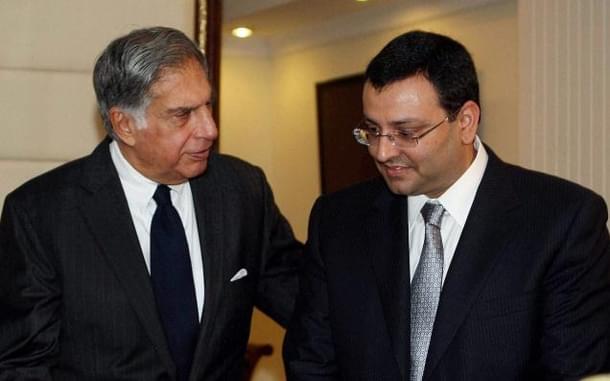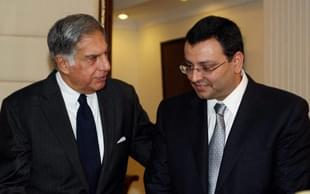Business
Why Cyrus Mistry’s Mission In Tatas Is Different From That Of Ratan Tata
R Jagannathan
Sep 14, 2016, 12:52 PM | Updated 12:52 PM IST
Save & read from anywhere!
Bookmark stories for easy access on any device or the Swarajya app.


Cyrus Mistry, the man who stepped into the oversized shoes of Ratan Tata less than four years ago in end-2012, has spent the bulk of his time since then trying to understand the group he inherited and what to do with it. Media-shy and self-effacing to a fault, Mistry has never responded to calls from the media for interviews, and it is thus no surprise that his first major interview has gone to an inhouse portal (www.tata.com) rather than anyone else.
It is an interview worth reading, for it gives us an insight into the man leading India’s largest business group, a group that went global with a vengeance just when it was about to go kaput in 2008. The group is now licking its wounds, especially Ratan Tata’s decision to overpay for the acquisition of Corus in 2007 by Tata Steel by raising loads of debt. Mistry’s toughest decision thus was to try and sell parts of Corus in Britain in order to prevent the acquisition from sinking the mother ship.
Mistry made five major points, either directly or indirectly, in his interview;
First, the group will now take “hard decisions on pruning the portfolio” due to the “challenging situations facing some of our businesses….”. This means the shape and size of the Tata Group will change in the coming decade as this pruning gets underway.
Second, cutting the losers out is not easy for the Tatas, for the group is both a brand and a conglomerate with diverse interests. He made this point in his own way: “Tata as a business group, when compared with private equity firms, has distinct advantages as well as some drawbacks. From a nurturing perspective, the Tata brand, developed over 15 decades, adds huge value to our companies. This also makes exits more difficult as the Tata group has a deeper commitment to stakeholders and the brand cannot be transferred.”
Put simply, conglomerates primarily have to focus on capital allocations between diverse businesses; a business group that is a brand in itself can’t take such clean decisions due to the emotion and expectations attached to the Tata brand. Hence the delays in chopping and changing the Tatas.
Third, in future group companies will have to earn the right to capital rather than expect the group to provide unquestioned support. “The group has invested Rs 415,000 crore ($79 billion) in capex over the last decade. Our investment over the last three years alone has been in excess of Rs 170,000 crore ($28 billion). We recognise that growth has to be a function of the operating cash flows we generate. At the group level, over the last three years, our operating cash flows have grown by over 30 percent CAGR; but this, as we know, is not the appropriate way to use such data - our individual companies need to earn the right to grow. At the group level, we are focused on helping our companies earn this right by building strong operational cash flows and looking at their capital structures.”
Clearly, cash guzzlers have to watch out.
Fourth, the right
way to look at debt is not at the group level, but the company level. He said:
“Over the last three years, the gross debt across the group has increased by about 2 percent per annum in US dollar terms, while cash and equivalents have grown at over 10 percent, leading to a reduction of 3.3 percent in net debt in the same period. As of March 2016, the group had a net debt of about $24.5 billion. Capex has been on average $9 billion in each of the last three years. In the financial year 2016, cash from operations reached $9 billion a year and exceeded the capex. At the group level, therefore, the aggregate debt is not something I feel concerned about. In fact, such aggregations at the group level could mislead, as the companies which have high cash generation, capex and debt are not all necessarily the same, and resources of different companies are not fungible with one another, as they are distinct legal entities with different shareholders.”
He didn’t quite say so, but effectively he meant that TCS, Jaguar Land Rover (JLR) and some smaller companies like Titan apart, debt is a problem in many Tata companies, including Tata Steel, Tata Power and Tata Teleservices. The future of the last company is clearly in doubt, as partner DoCoMo is seeking an exit, and the entry of Reliance Jio with huge investments makes the Tatas’ telecom entry a sure cash-guzzler in the future.
Fifth, Mistry also indirectly hinted that go-no-go decisions on investment or divestment cannot always come from a central directive. It has to be driven by domain expertise. He said: “There is no denying that domain strength is a critical factor for success in business. This may be more true in the future.”
While he made no reference to any company in this regard, it is a clear hint that decisions driven from the group level in areas where it had no expertise may not be optimal.
During Ratan Tata’s leadership of the group, many decisions were taken at his level and quite a few of them went wrong. While the Corus acquisition was merely wrongly timed or priced, the JLR acquisition, which turned out to have been the right one, was driven by Tata’s fascination for cars. But this very passion led him to convert a truck-maker like Tata Motors to make cars, and its truck DNA ensured future failure with the Indica platform. The Indica dazzled for a while, as its diesel engine gave huge mileage in an era of super-low diesel prices, but as more global car-makers came up with technologically superior cars, Indica lost out. The Nano, another Tata brainchild driven by his insight that two-wheeler riders may opt for a “cheap” car, proved to be a flop.
In the 1990s, Ratan Tata’s ideas on the group’s consumer businesses led to not one, but two, mistakes. He sold the FMCG company Tomco, when consumer businesses were to come into their own after liberalisation in 1991. And he did not think much of the chances of Titan, which turned out to be a roaring success. In the latter case, luckily Tata did not opt to throttle or sell Titan at birth. He left it to its own devices, and under Xerxes Desai, Titan turned out to be a winner.
The moral of the Ratan Tata period is that business groups or conglomerates cannot take decisions at the boss level, especially on the basis of one man’s vision or passions. Domain expertise is the key.
Cyrus Mistry, without actually saying so, is probably heading towards this conclusion. His time at the helm is a useful corrective to the grow-grow phase under Ratan Tata.
Jagannathan is former Editorial Director, Swarajya. He tweets at @TheJaggi.





